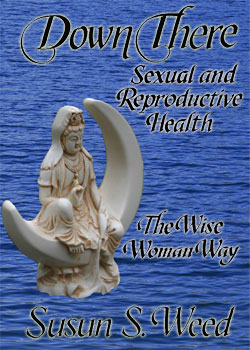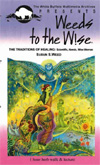Weeds in Your Garden? -- Bite Back!
c. 1999 Susun S. Weed
I always say the gardener's best revenge is to eat the weeds. I've been doing it for thirty years and can testify that my health and the health of my garden has never been better. Here are a few hints for gardeners who'd rather eat their weeds than hate them (and for non-gardeners who are adventurous enough to try out nature's bounty).
View your weeds as cultivated plants; give them the same care and you'll reap a tremendous harvest. Harvest frequently and do it when the weeds are young and tender. Thin your weeds and pinch back the annuals so your weeds become lushly leafy. Use weeds as rotation crops; they bring up subsoil minerals and protect against many insects. "Interplant" (by not weeding out) selected weeds; try purslane, lamb's quarters, or amaranth with your corn, chickweed with peas/beans, and yellow dock, sheep sorrel, or dandelion with tomatoes). And, most importantly, harvest your weeds frequently, regularly, and generously.
Overgrown radishes, lettuces, and beans are tough and bitter. So are weeds that aren't harvested frequently enough. Give your chickweed a haircut (yes! with scissors) every 4-7 days and it will stay tender all spring, ready to be added to any salad. If you forget a patch for two weeks, it may get stringy and tough and full of seed capsules. (All is not lost at this stage. The seeds are easy to collect - put the entire plant in a plastic bag in the refrigerator for 2-3 days and use the seeds that fall to the bottom of the bag - and highly nutritious, with exceptional amounts of protein and minerals.
Unthinned carrots and lettuces grow thin and spindly, so do unthinned lamb's quarters, amaranth, and other edible weeds. Wherever you decide to let the weeds grow, keep them thinned as you would any plant you expect to eat. Here's how I do it: In early spring I lightly top-dress a raised bed with my cool-method compost (which is loaded with the seeds of edible weeds). Over this I strew a heavy coating of the seeds of lettuces and cresses and brassicas (cultivated salad greens), then another light covering of shifted compost.Naturally, weed seeds germinate right along with my salad greens. When the plant are about two inches high, I go through the bed and thin the salad greens, pull out all grasses, smartweeds, cronewort, clear weed, and quick weed (though the last three are edible, I don't find them particularly palatable). And, I thin back the chickweed, mallows, lamb's quarters, amaranth, and garlic mustard and other edible wild greens.
Keep those annuals pinched back. You wouldn't let your basil go straight up and go to flower, don't let your lamb's quarter either. One cultivated lamb's quarter plant in my garden grew five feet high and four feet across, providing greens for salads and cooking all summer and a generous harvest of seeds for winter use.
When a crop of greens has bolted or gone to seed in your garden, you pull it all out and replant with another crop. Do the same with your weeds. We eat the greens of garlic mustard all spring, then pull it out just before it bolts (making a horseradishy vinegar from the choicest roots) -- often revealing a generous crop of chickweed lurking underneath.Some of my favorite garden weeds:
Annuals
o Amaranth (Amaranthus retroflexus) Young leaves, old leaves, even non-woody stalks are delicious as a cooked green; chop and boil for 30-40 minutes. Serve in their own broth; freeze leftovers for winter use. Use instead of spinach in quiche (you may never to grow spinach again). Collect seeds throughout the autumn by shaking seed heads over a lipped cookie sheet; or by harvest and dry the entire seed head. Winnowing out the chaff is tedious but soothing. There is a special thrill that comes when you toss the chaffy seed in the air, and the breeze catches it just-so, and the seeds fall back into your tray, while the prickly chaff scatters "to the four winds."
o Chickweed (Stellaria media) Young leaves and stalks, even flowers, in salads. Blend with virgin olive oil and organic garlic for an unforgettable pesto. Add seeds to porridge.
o Lamb's quarter (Chenopodium alba and related species, e.g. Chenopodium quinoa). Young leaves in salads. Older leaves and tender stalks cooked. Leaves dried and ground into flour (replaces up to half the flour in any recipe). Seeds dried and cooked in soups, porridge.
o Mallows (Malva neglecta and related species) Leaves of any age and flowers (the closely related Hibiscus flowers too!) are delicious in salads. Roots are used medicinally.
o Purslane (Portulacca oleracea) The fleshy leaves and stalks of this plant are incredibly delicious in salads and not bad at all preserved in vinegar for winter use.Biennials
o Burdock (Arctium lappa) Roots of non-flowering plants harvested after frost make a vinegar that is deep, and richly flavorful as well as a world-renowned tonic. Petioles of the leaves and the flowering stalk are also edible; for recipes see my book Healing Wise.
o Garlic Mustard (Alliaria officinalis) Year-round salad green. Leaves used in any season, even winter. Roots are harvested before plant flowers. Seeds are a spicy condiment.
o Queen Anne's Lace (Daucus carota) Leaves finely chopped in salads. Flowers are beautiful edible decorations. Roots of non-flowering plants, harvested in the fall, and cooked.Perennials
o Dandelion (Taraxacum officinalis) Leaves eaten at any time, raw or cooked, but especially tasty in the fall - not spring!. Roots harvested any time; pickle in apple cider vinegar for winter use. Dandelion flower wine is justly famous.
o Sheep Sorrel (Rumex acetosella) Leaves add a sour spark to salads. Cooked with wild leeks or cultivated onion and potato they become a soup called "schav."
o Stinging Nettle (Urtica dioica) Young leaves cooked for 40-45 minutes and served in their broth are one of my favorite dishes. Seeds can be used in baked goods, porridge.
o Yellow dock (Rumex crispus) Roots pickled in apple cider vinegar are tasty and a boon for enriching the blood. Leaves, especially young ones, are eaten raw or cooked.
For permission to reprint this article, contact us at: www.ashtreepublishing.com/contact
Susun Weed - PO Box 64, Woodstock, NY 12498
Visit Susun Weed at: www.susunweed.com and www.wisewomanbookshop.com
Susun Weed’s books include:
Wise Woman Herbal for the Childbearing Year
Author: Susun S. Weed.
Simple, safe remedies for pregnancy, childbirth, lactation, and newborns. Includes herbs for fertility and birth control. Foreword by Jeannine Parvati Baker. 196 pages, index, illustrations.
Order at: www.wisewomanbookshop.com
Healing Wise
Author: Susun S. Weed.
Superb herbal in the feminine-intuitive mode. Complete instructions for using common plants for food, beauty, medicine, and longevity. Introduction by Jean Houston. 312 pages, index, illustrations.
Order at: www.wisewomanbookshop.com

NEW Menopausal Years the Wise Woman Way
Author: Susun S. Weed.
The best book on menopause is now better. Completely revised with 100 new pages. All the remedies women know and trust plus hundreds of new ones. New sections on thyroid health, fibromyalgia, hairy problems, male menopause, and herbs for women taking hormones. Recommended by Susan Love MD and Christiane Northrup MD. Introduction by Juliette de Bairacli Levy. 304 pages, index, illustrations.
Order at: www.wisewomanbookshop.com
For excerpts visit: www.menopause-metamorphosis.com
Breast Cancer? Breast Health!
Author: Susun S. Weed.
Foods, exercises, and attitudes to keep your breasts healthy. Supportive complimentary medicines to ease side-effects of surgery, radiation, chemotherapy, or tamoxifen. Foreword by Christiane Northrup, M.D. 380 pages, index, illustrations.
Order at: www.wisewomanbookshop.com
Down There: Sexual and Reproductive Health the Wise Woman Way
Publication date: June 21, 2011
Author: Susun S. Weed
Simple, successful, strategies cover the entire range of options -- from mainstream to radical -- to help you choose the best, and the safest, ways to optimize sexual and reproductive health. Foreword: Aviva Romm, MD, midwife, 484 pages, Index, illustrations.
Order at: www.wisewomanbookshop.com
Abundantly Well - Seven Medicines The Complementary Integrated Medical Revolution
Publication date: December 2019
Author: Susun S. Weed
Seven Medicines build foundational health and guide you to the best health care when problems arise. Includes case studies, recipes, exentsive references and resources. Introduction by Patch Adams illustrated by Durga Yael Bernhard 352 pages, index, illustrations
Order at: www.wisewomanbookshop.com
Susun Weed's Video & CD's:Weeds to the Wise DVD Video
Visit Susun's farm for a weed walk. Hear her talk on the Three Traditions of Healing. Make infusion with her. Fun! (1 hour VHS video) Please note: this VHS video tape is in NTSC format which may not be compatible with video players outside of the USA and Canada.
Order at: www.wisewomanbookshop.com
Susun Weed's "It's Time"
Wise Woman Center
25th Anniversary Celebration CD
GODDESS CHANTS CD
Visit www.goddesschants.com to hear all the songs, read lyrics &
learn about the artists.
18 Wise Woman Songs & Chants from the heart
For Wholesale orders see our terms letter or contact us at:
Ash Tree Publishing PO Box 64 Woodstock, NY 12498 ~
Website: www.wisewomanbookshop.com ~ www.ashtreepublishing.com/contact
Susun Weed, green witch and wise woman, is an extraordinary teacher with a joyous spirit, a powerful presence, and an encyclopedic knowledge of herbs and health. She is the voice of the Wise Woman Way, where common weeds, simple ceremony, and compassionate listening support and nourish health/wholeness/holiness. She has opened hearts to the magic and medicine of the green nations for decades. Ms. Weed's Six herbal medicine books focus on women's health topics including: menopause, childbearing, and breast health. Visit her site www.susunweed.com for information on her workshops, apprenticeships, correspondence courses and more! Venture into the Menopause site www.menopause-metamorphosis.com to learn all about the Menopausal Years the Wise Woman Way.
Join Susuns Mentorship site for personal one on one mentorship! We also invite you to visit our commerce site www.wisewomanbookshop.com to learn about our Wise Woman publications, workshops, correspondence courses. As well as online courses at Wise Woman School.
back to articles index
back to press kit
© Susun Weed -Wise Woman Center
~ Disclaimer & Privacy Policy ~







